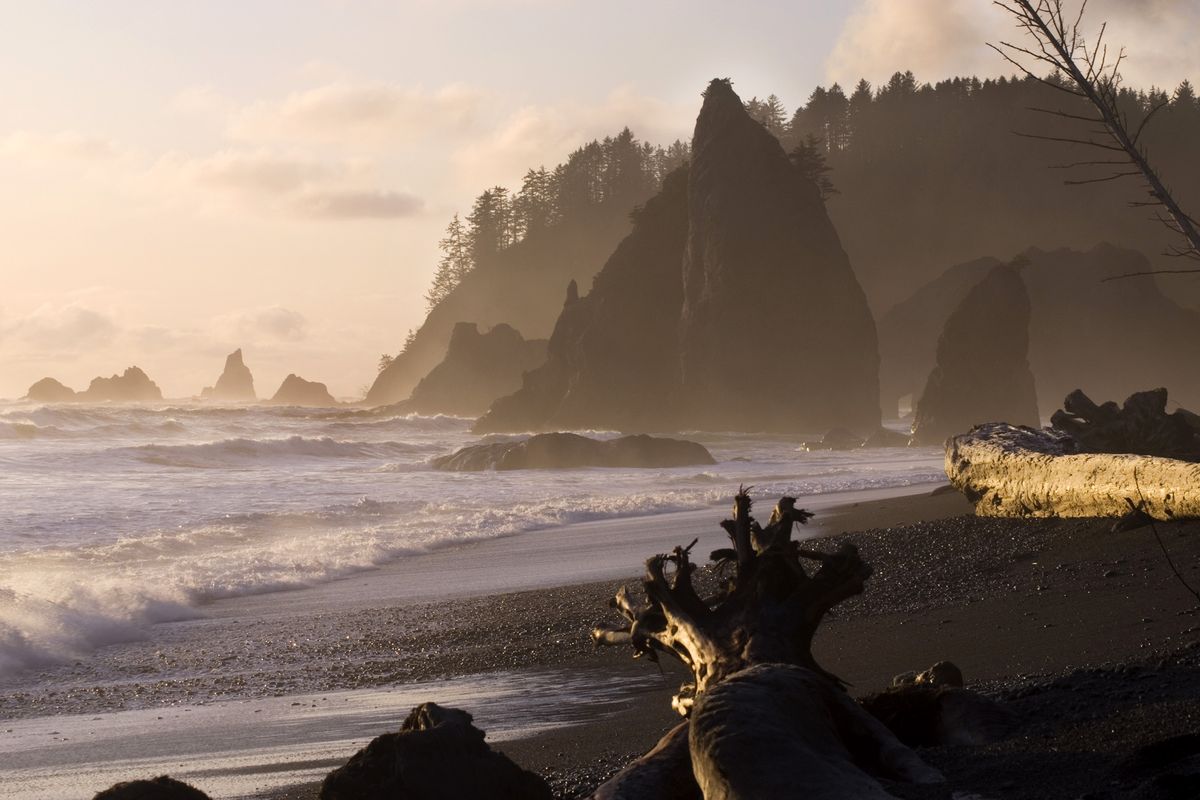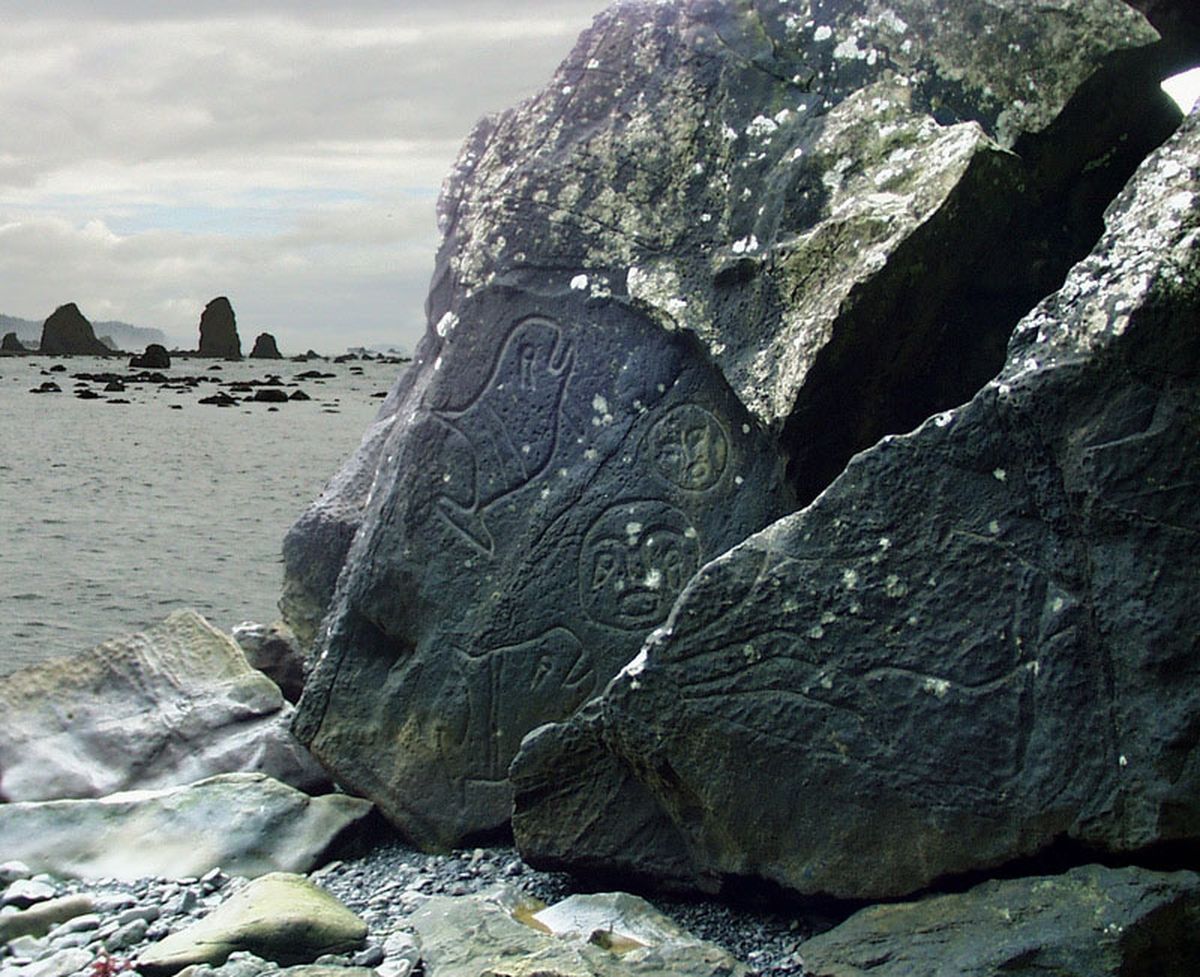Olympic national park celebrates diamond ‘in the rough’ anniversary
The sun sets along Rialto Beach, part of Olympic National Park. This beach is about a 30-minute drive north of La Push.
Olympic National Park is distinguished by its diversity.
A visitor to the jewel of the Olympic Peninsula can walk alone on a remote ocean beach. A short drive away, the same visitor can walk under moss-laden trees of the temperate rain forest.
A day trip to the park can end at Hurricane Ridge. Its 5,242-foot elevation allows a visitor to gaze south into the mountainous heart of the park or north to the Strait of Juan de Fuca and Vancouver Island.
The park is home to the largest unmanaged herd of Roosevelt elk in the Northwest, trees that were old before the first Europeans gazed upon the Olympic Peninsula, and delicate alpine wildflowers, such as the Piper’s bellflower, found only in the Olympic Mountains.
It’s that natural diversity that led to the park’s creation June 29, 1938.
As the park celebrates its 75th anniversary, here are some facts to spark your explorations.
ABOUT THE PARK
The park covers 922,651 acres of three distinct habitat zones, the alpine region, the coastline and the temperate rain forest. At 1,441 square miles, the park is larger than Rhode Island (1,214 square miles).
In 1897, the land that is now within the park was first federally protected when President Grover Cleveland designated the Olympic Forest Reserve.
In 1909, hoping to protect the habitat of Roosevelt elk, President Teddy Roosevelt used the Antiquities Act to designate part of the reserve as Mount Olympus National Monument.
In 1988, 95 percent of the park was designated as wilderness by Congress. This year the park started developing a wilderness stewardship plan.
Olympic is home to 910 campsites in 16 campgrounds, more than Mount Rainier (four) and North Cascades (five) combined. All but Kalaloch are available on a first-come, first-served basis.
Recreational visits to the park totaled 2,824,908 in 2012. The park had its highest visitation in 1997, with 3,846,709 visits.
The U.S. Highway 101 loop around the Olympic Peninsula gives motorists access to or near every entry to Olympic National Park as well as many places worth stopping outside the park.
HUMAN HISTORY
Eight tribes – the Hoh, Ozette, Makah, Quinault, Quileute, Queets, Lower Elwha Klallam and Jamestown S’Klallam – have made home on the Olympic Peninsula and the park land.
Archaeological investigations show human occupation of park lands dates back at least 12,000 years. More than 650 archaeological sites have been cataloged.
The Log Cabin Hotel, on the shore of Lake Crescent, was built in 1895. The current Log Cabin Resort sits on the same site.
WATER, SNOW AND ICE
Named glaciers in the park total 60. The longest glacier is the Hoh at 3.06 miles.
The 2.6-mile Blue Glacier is the largest in the park, measuring 500-1,000 feet thick.
Rope tows and a poma lift, first installed in 1958 at Hurricane Ridge, make Olympic one of only three national parks with lift-served ski runs open mid-December through March ( hurricaneridge.net). The defunct Deer Park Ski Area opened in 1936.
Fishing is available at “gobs of lakes in the park,” according to Bob Gooding of Olympic Sports Goods in Forks. “But most of them are a long walk and most of the people who visit them are hikers,” he said. Ozette Lake holds trout, yellow perch and bass. Lake Crescent is home to Beardslee strain rainbow trout and Crescenti cutthroat trout.
Razor clam digging normally is allowed in the Kalaloch area between South Beach and Third Beach, although the area was closed for the 2012-13 season.
Boat-in camping is available for paddlers at Lake Ozette, the third-largest lake in Washington. Several small backcountry camps along the shore can be reached by boat. The most popular destination is Ericson’s Bay Camp, the only one with pit toilets. The camp is about a 4-mile paddle from the boat launch at the north end of the lake.
Wheelchair-accessible routes include a path from Elwha Valley Road to Madison Falls, cascading over a green mossy cliff.
Waterfall destinations include a short walk (less than a mile) to the 50-foot Sol Duc Falls. Viewed from a bridge, the falls start above visitors’ heads and drop far below their feet.
The Elwha River restoration, started in September 2011, is the largest dam removal project in the United States, taking down the Elwha (began operations in 1913) and Glines Canyon (1927) dams. The $300 million project should be completed in fall 2014. When the removal is complete, an additional 70 miles of river habitat will be available for spawning by all five species of Pacific salmon and steelhead.
PARK CRITTERS
Viewing wildlife from black bears, mountain goats and Roosevelt elk to marmots, raccoons and birds is a prime attraction in Olympic National Park. Be sure to keep your distance, hang your food in the backcountry and don’t feed the critters.
Wildlife include 16 kinds of animals that are endemic to the park, such as the Olympic marmot, Olympic yellow-pine chipmunk and Arionid jumping slug.
Native fish species identified in the park total 37 native fish species, including the Olympic mudminnow found only on the peninsula and other locations in Western Washington.
PARK FLORA
Hoh Rain Forest features moss-covered trees, hanging lichen and thick trees blocking out the sun create an eerie beauty. The Hall of Mosses Trail has more green than inside of LeBron James’ wallet. Get away from the crowds by hiking or camping on the South Fork of the Hoh.
The rain forest receives 12-14 feet of rain each year, most of it falling during winter.
Vascular plant types growing on the peninsula number more than 1,450, roughly the same number found on the British Isles, an area 30 times larger, park scientists say.
The largest known Alaska yellow cedar is in the Quinault Rain Forest, just off the Big Creek Trail. It’s 37 1/2 feet in circumference and 120 feet tall. Hike the Valley of the Giants and view these towering trees. Info: quinaultrainforest.com.
A giant cedar tree rises 125 tall off Highway 101 near Ruby Beach.
Smooth Douglasia wildflowers are at the other end of the spectrum, thier pink petals just an inch or two aloft over a dense mat of green leaves among the rocks in the high mountains.
OLYMPIC MOUNTAINS
Highest point in the Olympic Mountains, Mount Olympus’ West Peak, is 7,980 feet above sea level. The mountain ranks fourth in the state in terms of prominence, but is not among Washington’s 100 highest peaks.
Mount Olympus was first sighted in 1774 by the Spanish explorer Juan Pérez, who named it “El Cerro de la Santa Rosalia.” On July 4, 1778, British explorer John Meares gave the mountain its current name.
Climbing Mount Olympus requires a 17.4-mile hike-in approach along the Hoh River just to reach the Blue Glacier.
Mount Anderson, elevation 7,330 feet, is at the center of three major watersheds in the Olympic Range. From its slopes, water flows into Puget Sound, the Strait of Juan de Fuca and the Pacific Ocean. Eleven major river systems flow out of the Olympics.
Hiking the entire Skyline Trail, a bucket-list trek for Northwest backpackers, is a 50-mile commitment on a south end of the park route that’s sometimes as primitive and challenging as it is scenic.
OLYMPIC COAST
Ocean beaches are easy to reach in areas such Ruby Beach, Rialto Beach and Kalaloch along the 73 miles of Pacific Ocean coastline in the park. Hikers also target remote destinations such as Shi Shi Beach.
The Point of the Arches is a National Natural Landmark at Shi Shi – a photographer’s dream. Hikers can link Cape Alava and Shi Shi for a scenic one-way hike if they study the tides and don’t get trapped.
Whales migrating from Baja California to Alaska often are seen from ocean overlooks in the Kalaloch area, especially from March through May.
Second Beach at the end of a sometimes-muddy 3/4-mile hike is worth the effort for viewing coastal beauty – and getting a visual on a scene visited by vampires in author Stephenie Meyers’ “Twilight” series.
Kalaloch is one of the most coveted campgrounds on the Olympic Peninsula. Reserve one of the 170 sites before making the drive June 19-Sept. 2.
Hole in the Wall, an arch in a rock outcropping on Rialto Beach, is a splendid photo opportunity and just a 1-mile stroll from the beach parking lot. Camping is permitted – raccoons will steal your food if you don’t use bear canisters. Can’t choose between Cape Alava and Rialto Beach? Link them with a 23-mile backpacking trip.
Rock skipping is an Olympic sport at Ruby Beach, where a short downhill walk from the parking lot leads to a beach covered with rocks worn smooth by the ocean.
HURRICANE RIDGE
Choose a hike, short or long, to view wildflowers, mountains including the North Cascades and the Strait of Juan de Fuca or learn about the park at the visitor center, open daily 10 a.m.-5 p.m.
STAIRCASE AREA
Staircase, in the southeast corner of the park, is the closest park access point to Tacoma and Olympia. Day hikes in the area range from easy (Rapids Loop) to challenging (Wagonwheel Lake).
North Fork Skokomish River Trail stretches follow the trail first cut by a military exploratory expedition in 1890. To cross the southern stretch of the Olympics, the soldiers cut a 5-foot-wide path across 93 miles of wilderness.
The Staircase name came from the cedar-log structure they built over a rock bluff across the river from the present-day campground. Until 1911, when the Shady Lane Trail was built, the “Devil’s Staircase” was the only way over the bluff.
A challenging 14-mile round-trip hike climbs to Upper Lena Lake.
THE NORTH SIDE
Sol Duc Hot Springs have a freshwater pool and three hot spring soaking pools varying in temperature. The pools are cleaned nightly and tested twice a day. The undeveloped Olympic Hot Springs are a less-crowded option, but the Olympic Hot Spring Road is closed during the Elwha Restoration project. The springs can still be accessed by hiking in over Aurora Ridge or Appleton Pass.
Lake Crescent is an ideal place to camp and play in the water.
High Divide loop trail, 20 miles, is one of the peninsula’s classic backpacking trips. The trip offers views of the mountains, lakes, waterfalls and an above average chance of seeing bears.
HITTING THE TRAIL
Trails in the park total 611 miles – that’s more the the driving distance from Spokane to Tacoma and back.
Enchanted Valley carved by the Quinault River offers an excellent 26.4-mile backpacking trip starting from the Graves Creek campground and incluidng waterfalls.
Lake Angeles, a sub-alpine basin with its trademark island, can be reached with a 3.5-mile climb from the Heart O’ the Hills Ranger Station. The trail is open to livestock. Extend the trek up to Klahhane Ridge and over Victor Pass before looping back to the ranger station via the Heather Park Trail to complete a 12.5-mile circuit.
Lake Constance trail climbs more than 3,000 feet in 2 miles and requires scrambling in some sections, offering experienced hiker a chance to get away from crowds.
Royal Lake visits require a 14-mile roundtrip hike that can be done in a day or as a backpacking trip. Start in Olympic National Forest off Forest Road 2870 south of Sequim, enter the park and head up Royal Creek.
Bailey Traverse, the park’s famous off-trail route usually traveled north to south, offers consistently stunning scenery and should only be attempted by experienced backcountry travelers with proven route finding skills. You’ll spend several days scrambling across the mountain tops to complete this trip and you aren’t likely to see many others along the way.



